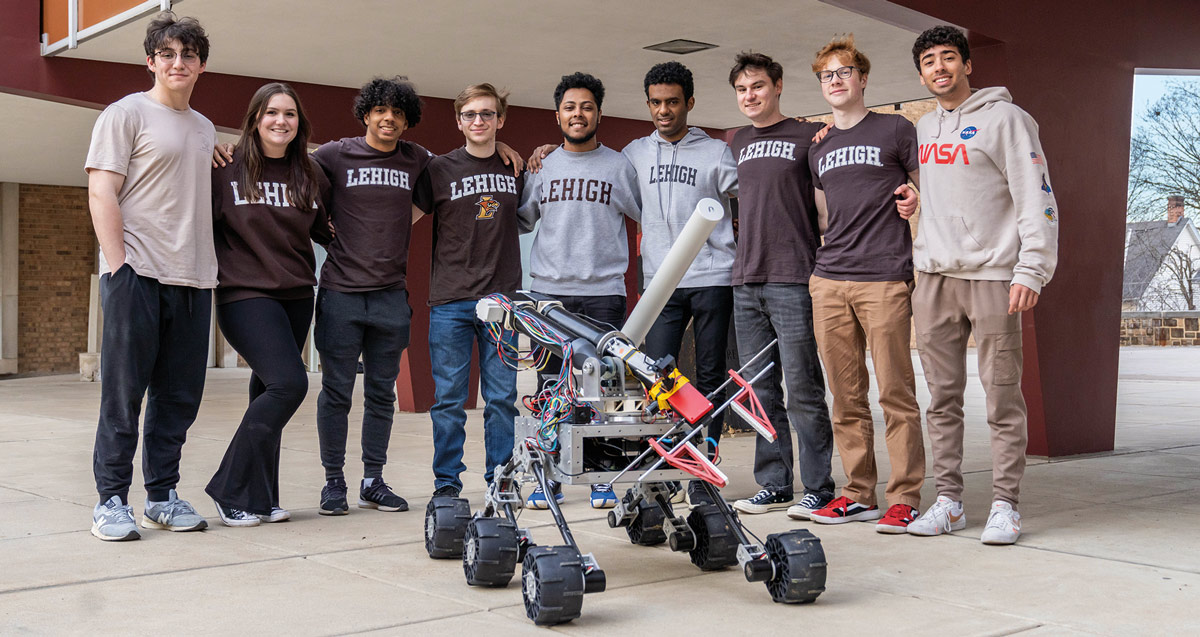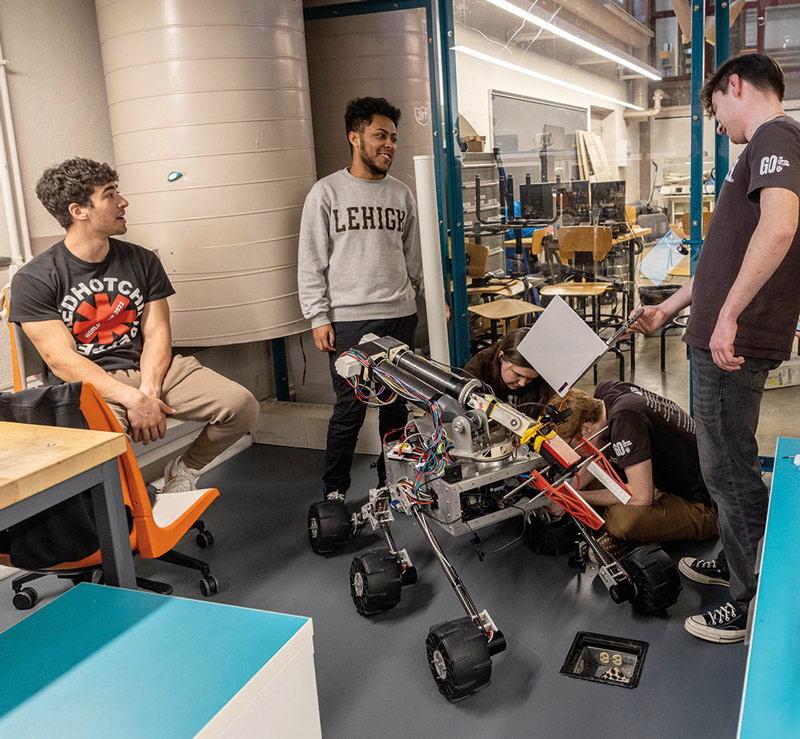
It didn’t exist when he first came to Lehigh, but Zemichael Gebeyehu ’24 had little doubt he could start a club for students interested in space. It was, after all, the university’s commitment to experiential learning that brought him here in the first place.
“I wanted to major in aerospace engineering, but that degree isn’t offered in Ethiopia,” says Gebeyehu. “So I was looking at schools in the U.S., and I got accepted into several of them, but Lehigh stood out because it emphasized doing stuff outside of class. And I really wanted hands-on experience building things related to space.”
 Once he got on campus, Gebeyehu—a mechanical engineering major whose love of the cosmos stemmed in large part from watching a documentary in grade school about one of the Apollo missions—joined several clubs, including Formula SAE and the Aerospace Club. He also found a group of similarly space-obsessed students.
Once he got on campus, Gebeyehu—a mechanical engineering major whose love of the cosmos stemmed in large part from watching a documentary in grade school about one of the Apollo missions—joined several clubs, including Formula SAE and the Aerospace Club. He also found a group of similarly space-obsessed students.
“I said to myself, Okay, I need to make this happen. I wanted to bring everyone together into one club where we could get hands-on experience related to designing, building, and testing space vehicles.”
He and three of his peers soon formed an executive board and applied for club status, and in the Fall 2021 semester, the Lehigh University Space Initiative (LUSI) was born. Today, the club has approximately 25 members representing a range of disciplines, including mechanical and software engineering as well as business, biology, and chemistry.
LUSI has three main goals, says Gebeyehu: growing a community of like-minded people, providing technical training (in CAD programs like SolidWorks, simulation software like Ansys, and space mission design), and providing opportunities to design and build.
The group created Lehigh’s first Mars rover, and entered it in the 2023 University Rover Challenge, an international competition held annually and sponsored by the Mars Society.
The challenge asks student teams to build a remotely operated vehicle that can accomplish four missions that simulate assisting astronauts on Mars—autonomous navigation, equipment servicing, extreme delivery, and conducting a science mission, which includes collecting and in situ analysis of a soil sample.
To secure an invitation to compete in the finals at the Mars Desert Research Station in Utah, LUSI submitted a written report and video detailing the design and operation of their rover. The team’s inaugural entry scored well but didn’t make the cut.
“The goal is to modify our current rover, and enter it again next spring,” says Gebeyehu. “So this fall, we’ll be doing a lot of iterating and testing, because it’s all about autonomous navigation, and the software aspect is very intricate.”
The club’s other project objective—to secure a contract with NASA’s CubeSat Launch Initiative—is longer term and very ambitious. A CubeSat is a nanosatellite capable of performing research in space. NASA’s initiative gives students the opportunity to design, develop, and build flight-ready spacecraft while simultaneously collecting relevant data from those spacecraft during an actual mission.
LUSI is outlining their design, research objectives, and funding stream in a proposal they’ll submit in November. If it’s accepted, NASA will fund the cost of flying the CubeSat on a future launch.
The team has been focused on the proposal for more than a year. “We have students working on the chassis of the satellite, the power systems, the solar arrays, and we’re designing it to study B Stars and massive stars,” says Gebeyehu. “If we get accepted, we’ll be able to start development of the hardware, and maybe by 2027 or 2028, the next group of LUSI students will be ready to launch it into space.”
It’s a big if, of course, as the competition will be stiff, and the team needs to show they’ve got the financial support to cover the extremely expensive, space-resistant materials they’ll need. But it wouldn’t surprise mechanical engineering and mechanics faculty member Terry Hart ’68 one bit if they’re able to pull it off.
“I just keep coming back to the fact that this club is an initiative that the students came up with on their own, and they made it happen,” says Hart, a former NASA astronaut and one of LUSI’s advisors. “They are very, very self-motivated with everything they’ve done, launching these two projects, competing on a national level with their rover, putting stickers on their rover like they do in NASCAR to raise the funds they need. They are more than just technically clever with everything they do.”
 Indeed, it is more than technical experience that has attracted students to the club. Michael Baron ’26 is a second-year student in the IDEAS (Integrated Degree in Engineering, Arts and Sciences) honors program who heads LUSI’s software team. He first heard about the group at the annual club fair, and came in with extensive experience building software for embedded systems, like those that can power a model rocket.
Indeed, it is more than technical experience that has attracted students to the club. Michael Baron ’26 is a second-year student in the IDEAS (Integrated Degree in Engineering, Arts and Sciences) honors program who heads LUSI’s software team. He first heard about the group at the annual club fair, and came in with extensive experience building software for embedded systems, like those that can power a model rocket.
“I wanted to get experience working in a group,” says Baron. “I’ve done a lot of projects, but most of them have been on my own. So I came to the club hoping to not only work with other very talented individuals, but also get some leadership experience.”
For the past year, he’s led the team that helped design the architecture for the software that drives the rover’s cameras and motors, as well as the ground station laptop that controls the vehicle. For the CubeSat proposal, he’s been outlining the computer and software components they’ll need to handle all the data coming from the satellite’s sensors and antennas.
Not every student has Baron’s background with such complex systems, and so he’s learned how to quickly assess his teammates’ understanding and guide them to ensure everyone is contributing in a meaningful, efficient way.
“It’s been great practice for whatever I end up doing after I graduate,” he says. “It’s one thing to be able to do a project by yourself, but if you can lead other people, and delegate responsibilities, that’s how the really big projects get done.”
And the LUSI projects are really big. Gebeyehu says the team pulled a string of all-nighters at Wilbur Powerhouse to make the submission deadline for their rover. “We lived at Wilbur,” he laughs. “We love that place. It has everything we need—CNC machines, a water-jet laser cutter, 3D printers. The additive manufacturing process really helped us out because we could build something quickly, iterate, print it, and test it. We were able to do some pretty quick prototyping, and we couldn’t have done it without Wilbur.”
Like Baron, Gebeyehu has learned as much about the power of so-called soft skills as he has the intricacies of designing spacecraft.
“Communication is so important,” he says. “We have a lot of people with different interests and different backgrounds, and you have to be able to manage them, but you also have to inspire them because the time commitments are intense. If I’m saying, ‘Hey, we’re going to pull an all-nighter to fix this,’ I have to be there. I have to be an example for them.”
Perhaps one of the best examples both Gebeyehu and Baron could set as leaders is demonstrating the possibilities of where all that hard work can lead. This summer, Baron interned at SpaceX, and Gebeyehu, at Apple. Both say their interviews for the positions focused heavily on the experiential learning they did through LUSI.
“Leading the software team for LUSI was a big reason I got that internship,” says Baron. “At SpaceX, they’re not focused as much on your classroom work, they want to see what you can actually do. And so having that experience of leading other students and building stuff was exactly what they wanted to see. Because that’s what you’ll be doing in the real world.”
-Story by Christine Fennessy
Photos: Christa Neu/Lehigh University
